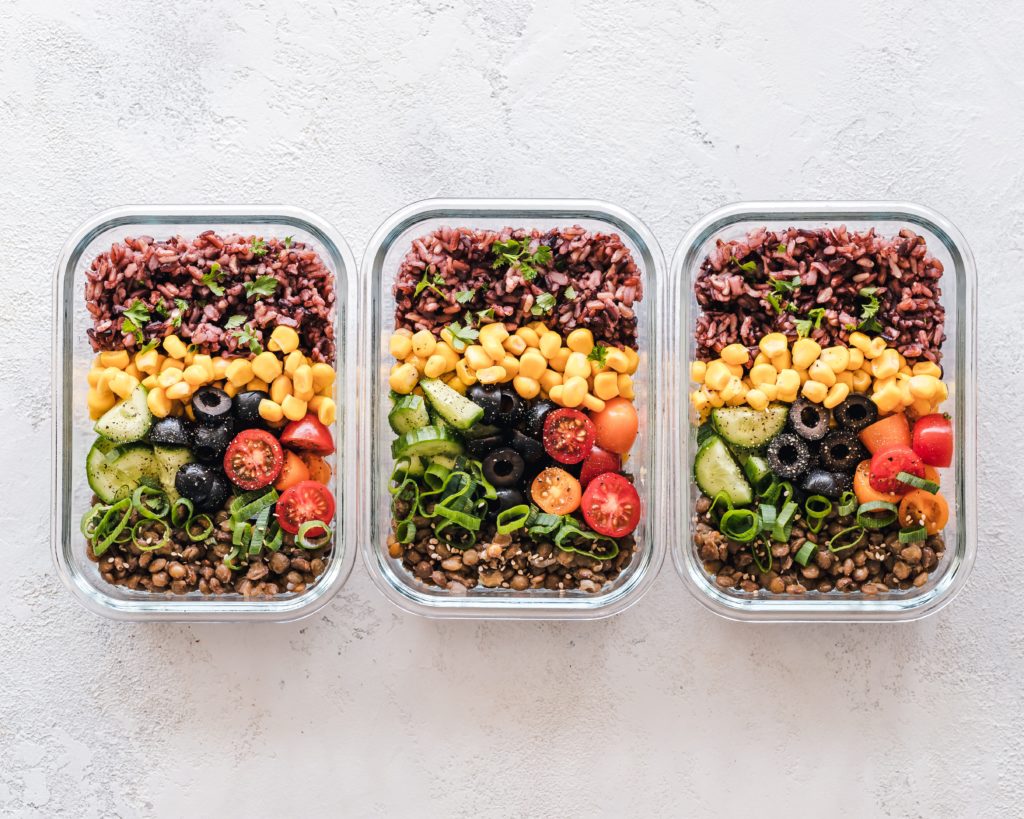We all know of the importance of a balanced lunch. What you pack in your kids lunchbox makes up a third of their daily intake, so it is important to ensure it is packed in a way that will sustain your child. Involving kids in building their own lunchbox will help foster healthy habits and set them up well for life ahead. We all know lunch is no good when it is sitting in the bin, so finding a balance between health and taste is key.

A BALANCED LUNCHBOX:
When building a lunchbox, try and aim for balance. The best way to do this is to ensure all food groups are represented – fruit, vegetables, wholegrains, protein and dairy. You could also break it down the following way:
- Fruit: 1-2 serves.
- Vegetables: 2+ serves. This can be part of lunch or separate.
- Something filling for lunch that contains both carbohydrates and protein e.g. a wholegrain wrap/sandwich with egg and lettuce or tuna and avocado; chicken noodle soup, pasta salad, veggie rice mix, sushi, leftovers from dinner etc.
- Protein rich snack: Greek yoghurt with berries and seeds, hummus or another dip with wholegrain crackers/veggie sticks, boiled egg, cheese and wholegrain crackers etc.
- A healthy surprise: e.g. homemade wholefood based treats, some dark chocolate, healthy trail mix (if school/day care allows nuts, or make one that is nut free and seed based).
TOP TIPS:
Fruit
- If serving sliced fruit that is susceptible to browning, squeeze some lemon or lime juice over the fruit prior to closing the lunchbox as this will help prevent oxidation.
- Berries are great bite sized option.
Vegetables:
- At least 2 serves. The more the merrier/whatever you can fit in the lunchbox.
- Focus on what the children like. If they’re fussy eaters, then perhaps it is about finding creative ways to include more vegetables e.g. sneaking them into savoury muffins or a quiche, making a dip etc. Also, persistence is key. Dips are great for fussy eaters e.g. hummus or pesto. Serve with some carrot/cucumber/celery and/or some wholegrain crackers. For more on fussy eating, check out this post.
- Choose different coloured vegetables to increase appeal. They can be included as part of a sandwich or salad or sliced separately, depending on the child’s preferences. Steamed, roasted or raw are all good.
Protein:
- This is what keeps kids full and helps them to be able to maintain their concentration and energy balance for the remainder of the day. Often many lunch boxes lack in this area.
- Examples: 1-2 boiled eggs, ½-1 cup chickpeas/lentils/beans, hummus (made from chickpeas), full fat yoghurt or Greek yoghurt with some berries/seeds.
- If making a sandwich, salad or wrap for lunch, ensure the filling or the mix has some protein e.g. egg, ham, tuna, cheese, hummus etc.
- Deli meats can be a quick and easy option, but are often laden with excess preservatives etc. Home-cooked meats are preferable, time permitting e.g. roast a chicken at the beginning of the week (they’re often around $3/$4 a kilo so super economical), tinned tuna and salmon, pre-boiled eggs, leftover meat from the night before.
Carbohydrates:
- Opt for wholegrain/wholemeal sources of carbohydrates as these are more nutrient dense and have a slower energy release. If your child prefers white bread, opt for more of a sourdough base (fermented), which helps feed the bacteria of the gut.
- Examples: wholegrain/wholemeal bread/wraps, pasta, brown rice, quinoa, couscous, noodles
Smart Snacks:
Ensure the pantry and the fridge are stocked with staples such as tinned fish, wholegrain crackers, tinned legumes, Greek yoghurt, frozen berries, wholegrains etc.
- Fresh fruit
- Veggies sticks with dip.
- Air-popped popcorn
- Wholegrain crackers with cheese
- Full fat yoghurt
- Fruit/savoury muffins/quiches
- Boiled eggs
- Nut-free trail mix
- Homemade banana bread
- Homemade mini muffins
- Homemade oat and banana pancakes
PACKING TIPS:
- Compartment-based lunchbox are useful in figuring out serving sizes.
- Use a cooler bag and/or ice brick to keep food cold. A frozen bottle of water is useful too on hot summer days.
- Freeze items such as sandwich bread, single serve yoghurts and homemade baked treats. They will be thawed and ready to eat at lunch time and keep other lunch box items cold.
- Variety is the spice of life, mix of the lunch options every few days as kids can get bored.
- Offer water as the drink of choice.
BALANCED LUNCHBOX EXAMPLES:
- Wholegrain pasta salad with pesto, baby bocconcini, tomato and olives; 1 boiled egg; a banana; sliced carrot and cucumber sticks with hummus.
- Wholegrain wrap with leg ham, avocado, cheese and lettuce; air popped popcorn; mixed berries, a homemade muffin.
- Greek salad with leftover chicken; wholegrain crackers with cheddar cheese; sliced watermelon; homemade banana bread.
- Sourdough sandwich with curried egg and lettuce; a sliced apple; a tub or pouch of Greek yoghurt, sliced capsicum and carrot and capsicum with dip.
- Warm legume and veggie soup; wholegrain crackers with cheese; sliced carrot with guacamole; a sliced orange.
- 2-3 mini quiches; sliced cucumber and cherry tomatoes; a banana, some baked beans, a homemade treat.
